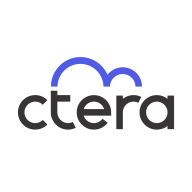

CTERA Enterprise File Services Platform and NetApp FAS Series are both in the file storage solutions category with cloud integration capabilities. CTERA shows strength in flexibility and a modern hybrid cloud approach, while NetApp provides superior scalability and advanced data management.
Features: CTERA Enterprise File Services Platform focuses on robust edge-to-cloud services, secure file sharing, and efficient endpoint backup. It is cloud-native, ensuring seamless integration into existing cloud environments. NetApp FAS Series offers advanced data management, including deduplication, high-performance storage solutions, and powerful on-premises capabilities.
Room for Improvement: CTERA could enhance its offerings by expanding compatibility with various cloud vendors, improving user interface designs, and offering more comprehensive training resources. NetApp might benefit from lowering initial setup costs, simplifying their user interface, and enhancing hybrid cloud integration capabilities.
Ease of Deployment and Customer Service: NetApp FAS Series provides a straightforward deployment model, with extensive documentation and customer support, tailored to large-scale enterprises. CTERA offers a flexible deployment process ideal for businesses seeking fast cloud integration with adaptable deployment options.
Pricing and ROI: CTERA Enterprise File Services Platform has a competitive initial setup cost, offering a strong ROI by reducing infrastructure expenses due to its cloud focus. NetApp FAS Series features a higher initial cost, justified by its comprehensive features and operational efficiency, providing solid ROI for enterprises focused on data management.
Adding SSD storage to Windows file servers is expensive, and we no longer need to back up those devices.
I am positive that CTERA has helped reduce the total cost of ownership by eliminating the need for manual storage management and reducing storage service processes.
If you have the configuration well maintained and configured, you should have good efficiency and compression for the clients and for yourself.
They swiftly address concerns and take ownership of the call, providing a very satisfactory support experience.
High-priority issues are handled promptly.
I would rate their support a ten out of ten.
Sometimes, the support was inadequate because the initial architecture was poorly defined.
We are also using it ourselves for the SAN and CIFS protocol.
They often provide basic solutions, such as suggesting a failover or a power cycle, which are not the sophisticated solutions we expect from a vendor.
If we need to upgrade CPU and memory, we should be able to do that without a license upgrade.
CTERA is a very scalable product, allowing us to grow.
It offers good scalability options, including vertical and outward scalability.
NetApp FAS Series is scalable, and it is possible, but you need to pay.
The NetApp FAS Series is scalable and offers numerous solutions, but only if customers are willing to invest in the shelves.
It has been pretty stable since then.
We had things deployed for years, and we were suddenly getting cloud sync issues that were crashing our sites.
It is very stable and reliable.
When panic occurs on the node, it reboots itself, and we have experienced numerous hardware-related issues.
AI and automation features could enhance the platform, such as AI-powered search, predictive storage analytics, and intelligent alerts for proactive monitoring.
The main problem is that if two people are working on the same file, for example, one in the U.S. and one in Israel, they can overwrite each other’s work without any notification.
It would help to have a global single-pane-of-glass view of all my CTERA devices.
Nutanix leads the business in this approach, and I feel that NetApp is missing some aspects, such as CPU, GPU, and RAM, in its AI portfolio.
There is an opportunity there for NetApp with Cloud Volumes ONTAP.
It was not possible to have a custom user inside ONTAP without the delete permission to delete the volume.
Unlike other solutions that require hardware purchases, CTERA offers software licensing with flexibility across multiple infrastructure providers.
CTERA’s pricing should be more proportional and accessible so that cost is not the factor preventing customers from purchasing.
CTERA's pricing seems to be on par with some of the other players, such as Nasuni and Azure.
The pricing of NetApp FAS Series is not cheap, but in comparison to other vendors, NetApp FAS Series is affordable.
As soon as something is written to the device, CTERA copies it to the cloud, where it's versioned with snapshots so we can recover it.
A vital advantage of this platform is its instantaneous recovery capability, allowing seamless access to a secondary gateway if the primary one fails.
It is a three-in-one solution for us. It is a file-sharing platform, an archiving solution, and also a backup solution.
While NVMe disks are expensive and require three disks for parity calculations, hard drives in NetApp FAS Series are inexpensive, making it more cost-efficient per GB, even with RAID tech implementation.
One important feature for customers is its ease of use and continuity, enabling seamless usage across on-premise and cloud environments.
At this moment, autonomous ransomware protection is the key feature.
| Product | Market Share (%) |
|---|---|
| NetApp FAS Series | 10.7% |
| CTERA Enterprise File Services Platform | 2.5% |
| Other | 86.8% |


| Company Size | Count |
|---|---|
| Small Business | 2 |
| Midsize Enterprise | 2 |
| Large Enterprise | 6 |
| Company Size | Count |
|---|---|
| Small Business | 30 |
| Midsize Enterprise | 37 |
| Large Enterprise | 57 |
The CTERA Enterprise File Services Platform provides a cloud-native global file system over public and private object storage, revolutionizing the world of hybrid cloud data solutions. Enhanced by a rich data services ecosystem, CTERA enables enterprises to gain full control of their data for optimal edge performance, data insight, and governance. The platform focuses on security, providing features like data encryption, access controls, and ransomware protection. Centralized management tools enable efficient data control and monitoring. The platform is being used to replace legacy NAS and file servers, especially at remote locations, and simplify backup and disaster recovery of file data while providing the flexibility of multi-cloud deployments with infinite scalability. CTERA is at the core of hybrid cloud transformations of some of the world’s largest banks, healthcare organizations, global media groups, and government agencies, in deployments that scale to tens of petabytes.
NetApp FAS series is an enterprise-level storage system that provides a wide variety of data management services, including data protection, block and file storage, and data management.
NetApp FAS is designed to be highly scalable, allowing your organization to grow storage capacity on demand. NetApp FAS also supports multiple protocols, including NFS, SMB, iSCSI, and Fibre Channel, as well as various storage architectures, including SAN (Storage Area Network) and NAS (Network-Attached Storage).
The FAS series has multiple data protection and data management features, including snapshots, cloning, replication, and deduplication, to help secure your data and manage it more efficiently. The system integrates with other NetApp products and solutions, to create a unified data management platform. The system can be deployed on-premise, on multi-cloud environments, or hybrid.
NetApp FAS Series Benefits and Features
NetApp FAS series provides its users with several key benefits and features, including:
Reviews from Real Users
NetApp FAS Series stands out among its competitors for a number of reasons. Several major ones are its speed, reliability, and a wide variety of features.
Adriano S., IT project and infrastructure service manager, writes, “The replication feature is noteworthy because it's faster than most and it uses little bandwidth. Then there's the friendly interface that the equipment offers. With this interface, it is very easy to manage.”
Temitope O., a NetApp product manager at Hiperdist Ltd, says, “I like the unified management feature because sometimes you end up running a single protocol on the entire system. You rather have a system for a particular protocol and another system for other protocols, especially in a big environment like mine.”
We monitor all NAS reviews to prevent fraudulent reviews and keep review quality high. We do not post reviews by company employees or direct competitors. We validate each review for authenticity via cross-reference with LinkedIn, and personal follow-up with the reviewer when necessary.